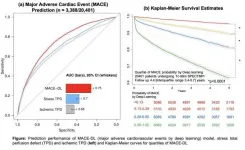(Press-News.org) The raucous calls of tree hyraxes -- small, herbivorous mammals -- reverberate through the night in the forests of West and Central Africa, but their sound differs depending on the location.
Tree hyraxes living between the Volta and Niger rivers make a barking call that is distinct from the shrieking vocalizations of hyraxes inhabiting other regions of the African forest zone.
A new study in the Zoological Journal of the Linnean Society co-authored by Yale anthropologist Eric Sargis finds that the barking hyraxes are a separate species from their shrieking neighbors. The newly described species, Dendrohyrax interfluvialis, populates the wet and dry forests that lie between the two rivers in coastal regions of southeastern Ghana, southern Togo and Benin, and southwestern Nigeria.
The researchers based their conclusion on the distinctive calls combined with anatomical and genetic differences they identified among tree hyrax populations.
"Sometimes a keen ear is as important as a sharp eye," said Sargis, curator of mammalogy and vertebrate paleontology at the Yale Peabody Museum of Natural History. "My co-authors John Oates and Simon Bearder were in Nigeria in 2009 researching galagos, a group of primates, when they noticed that the hyrax calls were different on one side of the Niger from the other. All the evidence we subsequently studied, including the distinctive vocalizations, points to a unique species in the forests between the Niger and the Volta."
Adult tree hyraxes typically weigh between 5 and 7 pounds -- about the size of a groundhog -- but they are closely related to elephants and manatees. They are usually regarded as nocturnal and tree dwelling, but their behavior has proved difficult to study, in part because, unlike most nocturnal mammals in Africa, their eyes don't shine at night, making them more difficult to spot, the researchers explained.
The researchers studied 418 recordings of tree hyrax calls made between 1968 and 2020 at 42 sites in 12 countries. Bearder, emeritus professor at Oxford Brookes University, produced sonograms from a sample of the 96 clearest and most complete recordings, including 34 from the population between the Niger and Volta and 62 from tree hyrax populations across West, Central, and East Africa, measuring their duration, frequency range, and repetition rates, among other characteristics. This analysis revealed that nearly all the calls recorded between the rivers were "rattle-barks" that differed from the shrieking calls recorded on the western side of the Volta and the eastern side of the Niger.
Sargis and co-author Neal Woodman of the U.S. Geological Survey and the Smithsonian National Museum of Natural History also studied the skulls of 69 adult tree hyrax specimens from six museum collections in Europe and North America. They found subtle but clear differences in the shape and size of skulls from specimens collected between the rivers and those gathered elsewhere. The skulls of D. interfluvialis were shorter and broader than those of their counterparts from outside the interfluvial zone, the study found.
An examination of museum skins, carcasses of hyraxes killed by hunters, and camera-trap imagery obtained in Ghana by co-author Edward Wiafe of the University of Environment and Sustainable Development revealed differences in fur color between D. interfluvialis and other populations, with the flanks and limbs of the former being brindled dark brown and lighter yellow-brown while the latter are dark brown to nearly black. Finally, genetic analyses of 21 samples of hyrax tissue from across the African rainforest found that the interfluvial populations were genetically distinct from other hyrax lineages, according to the study.
Oates, emeritus professor of anthropology at Hunter College in New York City, coordinated the study's various analyses. He has been studying the biogeography of the region inhabited by the newly described species since 1964, when he first heard the nocturnal calls of tree hyraxes on Bioko Island.
"There is increasing evidence that the Niger and Volta Rivers are significant biogeographic barriers to a range of mammals," Oates said. "Hyraxes, for instance, don't cross water easily, so it makes sense that, through millions of years of changing climate, as African forests have expanded and contracted, new species would have differentiated in isolated forest fragments known as refugia, and then have been limited in their subsequent dispersal by large rivers."
As a result, the region between the Volta and Niger now contains many unique animal species, the authors explain. The researchers warn, however, that the wildlife of the region between the Volta and Niger is under severe threat due to large and still growing human populations. Its forests have been reduced to fragments through a combination of commercial logging, tree cutting for firewood and charcoal production, plantation agriculture, and subsistence farming, they note, while most of the larger mammals are hunted for their meat. They call for increased efforts to create effective new nature reserves.
INFORMATION:
Reston, VA (Embargoed until 5:00 p.m. EDT, Sunday, June 13, 2021) - A new imaging technique has the potential to detect neurological disorders--such as Alzheimer's disease--at their earliest stages, enabling physicians to diagnose and treat patients more quickly. Termed super-resolution, the imaging methodology combines position emission tomography (PET) with an external motion tracking device to create highly detailed images of the brain. This research was presented at the Society of Nuclear Medicine and Molecular Imaging's 2021 Virtual Annual Meeting.
In brain PET imaging, the quality of the images ...
Reston, VA (Embargoed until 4:30 p.m. EDT, Saturday, June 12, 2021)--Positron emission tomography (PET) using a 68Ga-labeled fibroblast activation protein inhibitor (FAPI) can noninvasively identify and monitor pulmonary fibrosis, according to research presented at the Society of Nuclear Medicine and Molecular Imaging 2021 Annual Meeting. By binding to activated fibroblasts present in affected lungs, FAPI-PET allows for direct imaging of the disease process.
Idiopathic pulmonary fibrosis (IPF) causes substantial scarring to the lungs, making it difficult for ...
Reston, VA (Embargoed until 6:15 p.m. EDT, Friday, June 11, 2021)--An advanced artificial intelligence technique known as deep learning can predict major adverse cardiac events more accurately than current standard imaging protocols, according to research presented at the Society of Nuclear Medicine and Molecular Imaging 2021 Annual Meeting. Utilizing data from a registry of more than 20,000 patients, researchers developed a novel deep learning network that has the potential to provide patients with an individualized prediction of their annualized risk for adverse events such as heart attack or death.
Deep learning is a subset of artificial intelligence that mimics the workings of the human brain to process ...
For decades, the ice shelf helping to hold back one of the fastest-moving glaciers in Antarctica has gradually thinned. Analysis of satellite images reveals a more dramatic process in recent years: From 2017 to 2020, large icebergs at the ice shelf's edge broke off, and the glacier sped up.
Since floating ice shelves help to hold back the larger grounded mass of the glacier, the recent speedup due to the weakening edge could shorten the timeline for Pine Island Glacier's eventual collapse into the sea. The study from researchers at the University of Washington and British Antarctic Survey was published June 11 in the open-access journal Science Advances.
"We may not have the luxury of waiting for slow changes on Pine Island; things could actually go much quicker than expected," ...
PHILADELPHIA - Cells contain machinery that duplicates DNA into a new set that goes into a newly formed cell. That same class of machines, called polymerases, also build RNA messages, which are like notes copied from the central DNA repository of recipes, so they can be read more efficiently into proteins. But polymerases were thought to only work in one direction DNA into DNA or RNA. This prevents RNA messages from being rewritten back into the master recipe book of genomic DNA. Now, Thomas Jefferson University researchers provide the first evidence that RNA segments can be written back into DNA, which potentially challenges the central dogma in biology and could have wide implications ...
BOSTON - Vitamin D deficiency strongly exaggerates the craving for and effects of opioids, potentially increasing the risk for dependence and addiction, according to a new study led by researchers at Massachusetts General Hospital (MGH). These findings, published in Science Advances, suggest that addressing the common problem of vitamin D deficiency with inexpensive supplements could play a part in combating the ongoing scourge of opioid addiction.
Earlier work by David E. Fisher, MD, PhD, director of the Mass General Cancer Center's Melanoma Program and director of MGH's Cutaneous Biology Research Center (CBRC), laid the foundation for the current study. In 2007, Fisher and his team found something unexpected: Exposure to ultraviolet (UV) rays ...
For centuries, scientists, aeronautic designers and adventure-seekers have sought to replicate the qualities that allow birds to fly, namely wing-structure and balance. However, without an external mechanism such as a hot air balloon or airplane, humans have remained earth-bound, unable to use their own bodies to propel themselves into the stratosphere.
While researchers have long-focused on structural factors, like wings, that define the category of bird, a recent study published Science Advances by Professor Avihu Klar at the Hebrew University of Jerusalem's Faculty of Medicine and Prof. Claudio Mello from Oregon Health and Science University found that there are specific molecular characteristics that distinguish birds from animals, and these differences allow birds to flap their ...
The enormous potential of Big Data has already been demonstrated in areas such as financial services and telecommunications. An international team of researchers led by the IPK Leibniz Institute has now tapped the potential of big data for the first time on a large scale for plant research. To this end, data from three projects were used to increase the predictive accuracy for yield in hybrid varieties of wheat.
"We were able to draw on the largest dataset published to date, which contains information from almost a decade of wheat research and development," says Prof. Dr. Jochen Reif, Head of the Breeding Research Department at IPK. ...
What The Study Did: Editorial team composition by gender, race, ethnicity and sexual orientation was assessed at 25 leading medical and scientific journals in this survey study.
Authors: James W. Salazar, M.D., M.A.S., of the University of California San Francisco, is the corresponding author.
To access the embargoed study: Visit our For The Media website at this link https://media.jamanetwork.com/
(doi:10.1001/jamainternmed.2021.2363)
Editor's Note: The article includes conflicts of interest disclosures. Please see the article for additional information, including other authors, author contributions and affiliations, ...
What The Study Did: International medical graduates often practice as physicians in locations and specialties less preferred by U.S. medical graduates. This study reports on physician mortality from COVID-19, and on the mortality of international medical graduates in particular.
Authors: Abraham Verghese, M.D., of Stanford University in California, is the corresponding author.
To access the embargoed study: Visit our For The Media website at this link https://media.jamanetwork.com/
(doi:10.1001/jamanetworkopen.2021.13418)
Editor's Note: The article includes conflict of interest and funding/support disclosures. Please see the article for additional information, ...




